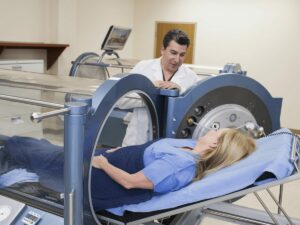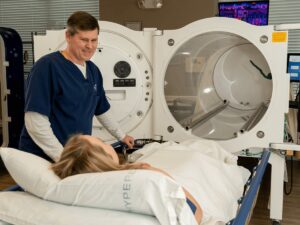Has anyone considered the potential of hyperbaric oxygen therapy in treating autism? This innovative approach is gaining traction, offering new hope in the management of autism symptoms.
As experts in hyperbaric therapy, we bring a wealth of knowledge and experience to the table, ensuring that you’re receiving information you can trust.
Hyperbaric oxygen therapy for autism offers more than treatment – it’s a journey towards better quality of life, driven by its encouraging results and potential for transformation.
In this guide, we’ll delve into the science, benefits, and treatment process of hyperbaric oxygen therapy for autism, providing you with a comprehensive understanding.
Read on to unlock the potential of hyperbaric oxygen therapy in transforming lives.
1. Understanding Autism Spectrum Disorder
The data from PsychCentral aligns with the statement that Autism Spectrum Disorder (ASD) affects 1 to 2% of the population, emphasizing its impact on communication and behavior. The spectrum nature of Autism Spectrum Disorder (ASD) implies a wide variation in the type and severity of symptoms experienced. This diversity means that each individual with ASD has a unique set of challenges and strengths.

The diagnosis of autism is typically made in early childhood, as developmental delays and social communication difficulties become apparent. The cause of autism remains a topic of ongoing research, with evidence pointing to a complex interplay of genetic and environmental factors. Understanding the individual nature of Autism Spectrum Disorder (ASD) is crucial for effective treatment and support.
2. Hyperbaric Oxygen Therapy (HBOT) Explained
Hyperbaric Oxygen Therapy (HBOT) is a medical treatment that involves breathing pure oxygen in a pressurized environment. This therapy takes place in a specialized chamber where atmospheric pressure is elevated above sea level, enabling the body to absorb more oxygen than under normal atmospheric conditions. This increased oxygen boosts tissue repair, reduces inflammation, and enhances immune response.

The application of HBOT has spanned a range of medical conditions, from wound healing to treating decompression sickness in divers. This therapy’s versatility is a testament to the fundamental role oxygen plays in our body’s healing processes. In the context of neurological conditions, the increased oxygen availability is thought to potentially aid in repairing brain tissue and enhancing neuroplasticity.
3. The Science behind HBOT and Autism:
With Hyperbaric Oxygen Therapy (HBOT) now explained, the subsequent topic will delve into how this therapy scientifically interacts with autism. Here are some key scientific insights into how HBOT interacts with ASD:
-
Increased Blood Oxygen Levels: HBOT significantly increases oxygen levels in the blood, which is theorized to enhance brain function. This can potentially improve cognitive and behavioral symptoms in individuals with autism.
-
Neuroinflammation Reduction: Studies suggest HBOT can reduce neuroinflammation, a common feature in many with autism. Reducing inflammation in the brain could alleviate some of the
neurological symptoms associated with ASD.
-
Neuroplasticity Enhancement: By increasing oxygen in the brain, HBOT may promote neuroplasticity, potentially improving learning and adaptive behaviors in individuals with autism. Seeing these improvements has been a highlight in the application of this therapy.
-
Oxidative Stress Mitigation: HBOT helps in reducing oxidative stress, which is believed to play a role in the development and severity of autism symptoms.
-
Promoting Cellular Repair: HBOT’s role in enhancing cellular repair and regeneration is particularly relevant in autism, where developmental delays are common. For example, improved cell function in the brain could lead to advancements in speech and motor skills in autistic individuals.
4. Benefits of HBOT for Autism
Having examined the scientific connection between HBOT and autism, the discussion will now turn to the various benefits HBOT offers to individuals with autism. Let’s explore some key benefits:
Improved Cognitive Function
HBOT has shown promise in enhancing cognitive abilities in individuals with autism. This improvement is attributed to the increased oxygen supply to the brain, which can aid in better brain function and connectivity. Studies show improved language and social skills in autistic individuals. Improved cognitive function can lead to greater independence and a better quality of life for these individuals.
Enhanced Behavioral Outcomes
Behavioral challenges are a common concern in autism, and HBOT has been noted to positively impact these areas. The therapy can lead to a reduction in repetitive behaviors and irritability, which are common in autistic individuals. Additionally, improvements in social responsiveness and overall behavior have been documented, contributing to a more stable and engaging social environment for these individuals.
Increased Physical Health
Physical health improvements are another significant benefit of HBOT for autism. The therapy can enhance overall physical well-being by boosting immune system function and reducing gastrointestinal symptoms, which are often prevalent in individuals with autism. Improvements in sleep patterns and general physical health have also been reported, contributing to better overall functioning and quality of life.

5. HBOT Treatment Process
Transitioning from the benefits of HBOT in autism therapy, the next area of exploration will be the procedural aspects of undergoing HBOT treatment. Here are some steps of the HBOT process for a clear understanding of this treatment:
Step#1 Initial Assessment
The HBOT journey begins with a thorough initial assessment. This stage involves evaluating the individual’s medical history and specific needs related to autism. It’s crucial to determine the suitability for HBOT and to tailor the treatment plan effectively. The assessment not only focuses on the autism-related challenges but also considers overall health to ensure a safe and effective HBOT experience.
Step#2 Treatment Planning
Once the initial assessment is completed, a detailed treatment plan is formulated. This plan outlines the frequency, duration, and intensity of the HBOT sessions. Treatment planning is a collaborative process, involving input from a multidisciplinary team. This ensures a holistic approach to addressing the individual’s needs. Factors like age, symptoms, and overall health are considered in creating a personalized treatment plan.
Step#3 The HBOT Session
An HBOT session typically involves the individual entering a hyperbaric chamber where they breathe in pure oxygen at higher-than-normal atmospheric pressures. Sessions at OxygenArk are conducted in state-of-the-art chambers, ensuring comfort and safety throughout the process. Each session, ranging from 60 to 90 minutes, is closely monitored by trained professionals for safety and efficacy.

Step#4 Monitoring and Adjusting Treatment
Continuous monitoring is an essential aspect of the HBOT process. Specialists meticulously observe progress and adjust the treatment as necessary to enhance outcomes. This can include changes in session length, frequency, or other treatment aspects. Frequent assessments are crucial in evaluating the therapy’s effectiveness and ensuring the individual’s needs are continuously addressed.
Step#5 Post-Treatment Evaluation
The HBOT journey concludes with a post-treatment evaluation. This final step assesses the overall effectiveness of therapy and any changes in the individual’s autism-related symptoms. OxygenArk utilizes this evaluation to assess improvements and suggest recommendations for future care or additional therapies. This evaluation not only highlights the achievements but also paves the way for ongoing support and care.
6. Risks and Safety Concerns
Building on the description of the HBOT treatment process, the following discussion will focus on identifying the potential risks and safety measures in HBOT therapy. Let’s review HBOT risks and safety concerns:
Risk of Ear Pressure Discomfort
One of the risks associated with HBOT is ear pressure discomfort. This happens due to changing atmospheric pressure in the chamber, causing sensations like those during airplane takeoffs, leading to ear pressure or mild pain. To mitigate this risk, specialists instruct patients on techniques to equalize ear pressure. In some cases, tubes might be inserted for those who have difficulty with pressure equalization.
Risk of Oxygen Toxicity
Prolonged exposure to high levels of oxygen can lead to oxygen toxicity, a condition that can affect the lungs and central nervous system. Symptoms may include disorientation, breathing difficulties, or vision changes. To prevent oxygen toxicity, treatment protocols are carefully designed to limit exposure to high oxygen levels. Regular monitoring during sessions aids in early detection of toxicity for prompt intervention.
Claustrophobia
The enclosed space of the hyperbaric chamber can induce claustrophobia in some individuals. This can lead to anxiety or panic, which may affect therapy’s effectiveness. For those with claustrophobia, gradual acclimatization to the chamber environment is encouraged. Transparent chambers and communication with the outside are used to ease anxiety. Adjusting to individual comfort levels is essential for effective treatment.
7. 5 Tips for Choosing the Right HBOT Provider
After discussing the risks and safety concerns of HBOT, the focus will shift to providing guidance on selecting the most suitable HBOT provider. Here are specific tips to guide this important decision:
#1 Specialized Experience in Autism Treatment
Look for providers who specialize in using HBOT for autism. This specialization suggests a deeper understanding of the specific therapeutic needs and challenges associated with autism. Providers specializing in autism often use customized protocols and treatments. For example, a specialized provider might offer a sensory-friendly environment, essential for autistic individuals sensitive to overstimulation.
#2 Certification and Standards Compliance
It’s important to check that the HBOT provider holds relevant certifications, such as those from the Undersea and Hyperbaric Medical Society (UHMS) . These certifications indicate adherence to international standards in hyperbaric treatment. They also ensure that the provider is trained in the latest safety protocols and therapeutic techniques.
|
Aspect
|
Consideration
|
Importance
|
|
Certifications
|
Check if the HBOT provider holds relevant certifications, such as those from the Undersea and Hyperbaric Medical Society (UHMS).
|
Certifications from reputable organizations like UHMS indicate that the provider has undergone recognized training, ensuring competence in safety protocols and therapeutic techniques.
|
|
Standards Compliance
|
Ensure that the provider adheres to international standards in hyperbaric treatment. This includes compliance with safety protocols and recognized therapeutic techniques.
|
Compliance with international standards is crucial for the safety and effectiveness of hyperbaric treatment. It ensures that the provider follows established practices and prioritizes patient well-being.
|
#3 Patient Reviews and Success Stories
Investigate patient reviews and success stories, particularly those related to autism treatment. Positive feedback and detailed accounts of improvement in autism symptoms can be indicative of the provider’s expertise and effectiveness. Reading success stories highlighting a major improvements in communication and behavior offer insights into a provider’s efficacy with HBOT for autism.
#4 Technological Advancements
Check if the facility uses the latest hyperbaric chamber technology, such as chambers with built-in entertainment systems or adjustable pressure settings. Advanced chambers may also offer features like transparent walls for reducing claustrophobia or integrated communication systems for continuous contact with medical staff during sessions.
#4 Facility Quality
Evaluate the facility’s overall environment, ensuring it is clean, well-maintained, and accessible. A high-quality facility should have a comfortable waiting area, private treatment rooms, and clear signage. Look for features that enhance patient comfort and safety, such as adjustable beds and emergency medical equipment.

Conclusion
This comprehensive guide has illuminated the potential of Hyperbaric Oxygen Therapy (HBOT) for autism, offering insights into its benefits, the treatment process, and tips for choosing the right provider. It serves as a valuable resource for anyone considering HBOT as part of an autism treatment plan.
Explore the transformative power of HBOT with OxygenArk, where cutting-edge technology meets compassionate care. For more information and to discuss your specific needs, feel free to contact us.












